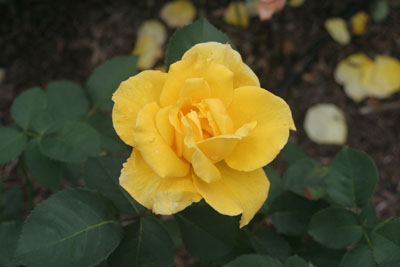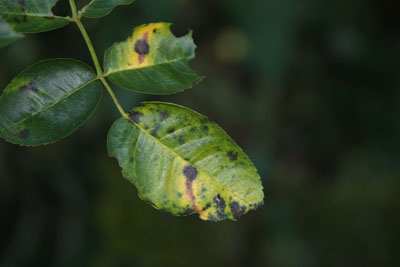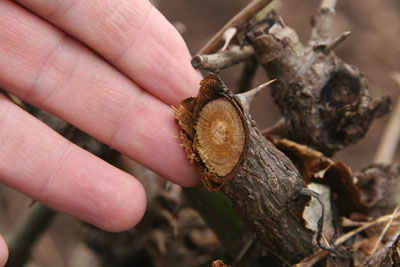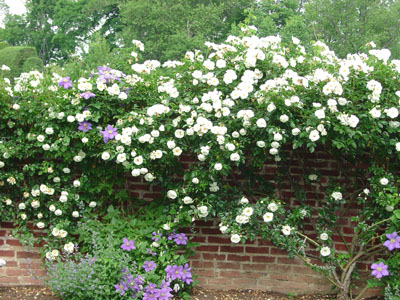 Knock-out Rose. (All photos: Bob Westerfield)
Knock-out Rose. (All photos: Bob Westerfield)Popularity of Roses
Roses are one of the most popular plants among Georgia gardeners even though growing roses in the southern climate can be challenging. Knowing which rose varieties to choose is the key to success. Hybrid Tea roses are one of the most popular varieties on the market today, but they are also one of the most difficult to grow in Georgia. Knock-out roses, on the other hand, are one of the easiest roses to grow in the South.
Types of Roses
With more than 6,000 rose cultivars available, selecting the right roses to grow can be challenging for some gardeners. Roses are classified according to their growth habit and flower form.
 Hybrid Tea Rose.
Hybrid Tea Rose.Hybrid Tea roses have a strong, upright growth habit and large, single flowers on long stems. They are the best to use for cut flower arrangements.
Floribunda roses have small to medium-size flowers that bloom profusely in clusters on medium-length stems. Some are fragrant and low-growing.
Grandiflora roses can grow 5 to 6 feet tall. Flowers are borne in clusters on long stems. They combine the features of Hybrid Tea and Floribunda roses.
Climbing roses have long, arching stems that are usually attached to supports such as arbors, trellises, fences or posts. They can also be grown on walls or as ground covers on banks. They bloom continuously during the summer and fall. Their flowers form dense clusters on long canes, which can grow 20 feet in one season.
Old Roses or Heritage roses are cultivated garden roses that existed before 1876 and have not been genetically improved through selective breeding. Most are fragrant, disease-resistant and have diverse growth habit and flower form.
Shrub roses grow about 3 feet tall and wide. They can have single or double flowers in clusters, and come in red, pink and yellow colors. Shrub roses bloom continuously through the summer and fall. They have a light tea rose fragrance and are resistant to diseases.
Cultural Practices
Site selection is important. Roses need six to eight hours of direct sun each day. Morning sun is essential. Good air movement dries dew and rain quickly, discouraging diseases. Good drainage and moderately fertile soil will benefit growth. Amend the soil with at least 4 inches of organic matter.
 Hybrid Tea Rose.
Hybrid Tea Rose.Roses should be planted 5 to 6 feet apart in February. Dig a hole large enough to place the roots without crowding. The graft union (the enlarged area on the main stem) should be 1 inch above the soil level. Water thoroughly after planting.
Container-grown roses should be planted no deeper than they were in the original container. Loosen the roots if they are pot-bound.
Mulching roses with fall leaves, pine straw, ground pine bark mini- nuggets or cypress chips is beneficial. Mulch will help prevent the soil from eroding and drying quickly, maintain a uniform soil temperature and reduce weeds.
 Hybrid Tea Rose.
Hybrid Tea Rose.Water roses thoroughly at least once a week during dry weather. Use drip irrigation if possible and allow moisture to penetrate to a depth of 5 to 6 inches.
Soil testing is recommended to determine the soil's need for lime and fertilizer. Without a soil test, it is generally recommended to use three tablespoons per plant of 16-4-8 or 12-4-8 fertilizer each month from March through September. Spread the fertilizer in a circle around the plant. Rake it lightly into the soil and water after application.
Pruning roses will make them bloom more profusely. Prune Hybrid Teas, Floribundas and Grandifloras in late winter before growth begins. Prune weak-growing cultivars lightly, and vigorous-growing varieties more heavily. Remove weak or wounded canes and shoots that originate below the graft union.
Prune climbing roses after the first flush of blooms fade. It is customary to prune back about one-third of their total length. Also remove any weak or damaged canes. Use sharp clippers and make clean cuts just above a bud.
Management of Diseases and Insects
Black spot, powdery mildew, petal blight, crown galls and stem cankers are common rose diseases in Georgia. Thrips, spider mites and aphids are the most common insects. Proper spacing, pruning and cultivar selection will reduce many disease and insect problems. Sometimes it is necessary to spray a labeled pesticide to control these problems, particularly on Hybrid Tea roses.
 Black Spot Disease.
Black Spot Disease. Poorly Pruned Stem.
Poorly Pruned Stem.Selected Varieties
Below are a few cultivars that grow well in USDA Hardiness Zones 5 to 10 and AHS Heat Zones 5 to 12.
Hybrid Teas
Alabama (pink blend), Cayenne (orange blend), Chrysler Imperial (dark red), Matterhorn (white)
Grandifloras
Arizona (orange blend), Love (red blend), Queen Elizabeth (pink), Scarlet Knight (red)
Floribundas
Angel Face (mauve), Apricot Nectar (apricot blend), Charisma (red blend), Bahia (orange blend), Gene Boerner (pink), Saratoga (white), Sunsprite (yellow)
 Climbing Rose.
Climbing Rose.Climbers
America (pink blend), Crimson Glory (dark red), Peace (yellow blend), New Dawn (light pink)
Shrubs
Meidiland Series, Care-free Wonder, Bonica, Knock-Out Series
Status and Revision History
Published on Apr 14, 2011
Published with Minor Revisions on Apr 24, 2014
Published with Full Review on Jul 07, 2022


























































